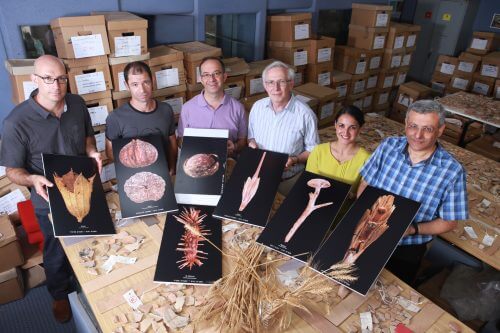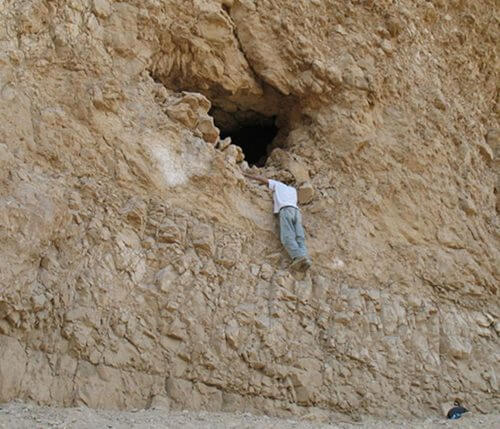This is according to a study by an international team of researchers led by Israeli researchers who conducted the first mapping of the barley genome from 6,000 years ago from a cave in Masada Cliff

The world's first mapping of the genome of prehistoric barley grains from the Chalcolithic period 6,000 years ago (Stone and Copper Age) done by an international team of researchers from leading research institutions around the world led by Israel shows that the place where barley domestication began was here in Israel, in the north of the Jordan Valley and the Galilee region the top This is the oldest plant genome that has been reconstructed so far. The results appear this week in the prestigious journal Nature Genetics. "Most of the research of archaeobotanical findings has been limited so far to the comparison between ancient and contemporary specimens based on their external structure. The fact that we were able to map the genome of 6,000-year-old barley grains allows us for the first time to get a more reliable picture of the origin and domestication processes of barley, which were a central part of the agricultural revolution in which our ancestors moved from a society of hunter-gatherers to permanent societies based on agriculture. the researchers
The initiators of the research are Prof. Ehud Weiss from the Department of Palestine Studies and Archeology at Bar-Ilan University and Prof. Zion Fahima, head of the Institute of Evolution at the University of Haifa, along with teams of researchers from Bar-Ilan University, from the University of Haifa, from Tel-Hai Academic College, from the Hebrew University, from the Leibniz Institute for Plant Genetics and Field Crop Research (IPK) in Gatersleben, Germany, from the Max Planck Institute for the Sciences of Human History in Jena, Germany, and more. The research began by climbing on a rope ladder to a cave located 100 meters below Masada Peak, continued the ancient DNA sequencing, and ended by comparing the data to a genetic database of hundreds of barley DNA strains from all over the world to identify the place where they started Humans first domesticated barley.

The approximately 6,000-year-old seeds were excavated in Yoram's cave located on the southern cliff of Masada, in the Judean desert, near the Dead Sea. These grains and tens of thousands of other plant remains were found during a systematic archaeological excavation under the direction of Dr. Uri Davidovich from the Institute of Archeology at the Hebrew University in Jerusalem and Dr. Nimrod Marom from the Zinman Institute of Archeology at the University of Haifa. The access to the cave, which is located about 100 m below Masada Peak, is very difficult and requires climbing on top of a vertical cliff. "The cave was used by humans only for a short time during the Chalcolithic period, about 6000 years ago, apparently as a temporary shelter," Davidovich and Marom explain.
"These archaeological remains give us a unique opportunity to map for the first time the genome of a plant from the Chalcolithic period. The genetic material was well preserved for thousands of years thanks to the extreme aridity and conditions prevailing in the area's caves," explains Prof. Weiss, in whose laboratory the archaeobotanical analysis of the find was done, in collaboration with his student Michal David. To determine the age of the ancient grains, the researchers cut through each grain, half a grain was used for dating with the carbon-14 method while the other half was used to sequence the ancient DNA. So far, a similar success is known only in the reconstruction of genetic information in prehistoric corn from the southern United States, and that too, from a much later time period. "For us, ancient DNA is a kind of time capsule that allows us to travel back in history and observe the domestication process of food plants at unique points in time in the past," Weiss explains.
Extracting and sequencing ancient DNA from 6000-year-old grains, which was done in the laboratory of Prof. Johannes Kraus from the Max Planck Institute for the Sciences of Human History in Germany, is not trivial, because DNA is broken into small pieces of only 70-20 letters. "Restoring the barley genome, which contains about 5 billion letters from such short segments, is like trying to restore an ancient pottery jar that broke into millions of tiny pieces. But the genomic technologies that exist today and the tremendous computing power at our disposal allowed us to perform a virtual fusion of the DNA fragments and reconstruct large parts of the genome, in a way that would allow the understanding of the entire genome," explains Dr. Shariel Hibner, from the Tel Hai Academic College whose laboratory is located in the Institute for Scientific Research in the Galilee (Migal).
Wheat and barley underwent ZA domestication, a transition from the state of a wild plant to the state of a cultivated plant that was grown for food already about 10,000 years ago, in the Fertile Crescent region, which extends from present-day Israel and Jordan, through Lebanon, Syria and Turkey to Iraq and Iran. To this day, the wild varieties of these important food plants continue to exist in the area, and they are among the main cereal species studied at the Institute of Evolution at the University of Haifa. "The origin of seed farming is in our region, and later it spread from here to Europe, Asia and North Africa. The current research shows that wild barley was domesticated in the north of the country, in the north of the Jordan Valley and the Upper Galilee, and from there it spread to the rest of the world," explain Prof. Zion Fahima and Prof. Avraham Kurol from the University of Haifa.
Dr. Nils Stein, who conducted the comparison of the ancient and modern genomes at the Leibniz Institute for the Study of Plant Genetics and Field Crop Research, says "Our analysis shows that seeds grown 6,000 years ago are genetically very different from the wild varieties found in the area today. However, they show considerable genetic overlap with domesticated varieties used in traditional agriculture in our region." This finding indicates, in the opinion of the researchers, that despite all the occupations and migrations that the area has known for thousands of years, the local residents preferred to grow the "traditional varieties" that exist and are adapted to the conditions of the area, over seeds of food plants from their countries of origin.
The comparison between the ancient grains and 113 lines of wild barley collected along the Fertile Crescent, and another 137 "traditional varieties" (that is, local barley varieties that are used by farmers in traditional agriculture in the Near East), allowed Dr. Shariel Hibner from Tel Hai Academic College, together With Prof. Zion Fahima and Prof. Avraham Korul from the University of Haifa, to calculate the genetic relationship between all the varieties. The calculation revealed that the geographical origin of barley domestication was in the north of the Jordan Valley and the Upper Galilee region. "Genetic findings are supported by another finding of two nearby archaeological sites, where the oldest remains of barley cultivation have been found so far," the researchers explain.
Despite the fact that random hybridizations with wild barley have occurred repeatedly over the past 6,000 years, the prehistoric grains from Masada are surprisingly similar to the contemporary "traditional varieties" from the eastern Mediterranean. "This is an amazing find, considering the huge change in the weather, the local flora and fauna, and agricultural methods in this long period of time," says Dr. Martin Thans from the Leibniz Institute for Plant Genetics and Field Crops Research.
The current research combining botany and archeology with genomics and bioinformatics has brought new insights into the origin of our food plants. "This is just the beginning of a new and fascinating series of studies," says Prof. Weiss "DNA analysis from archaeological remains of prehistoric plants will provide us with new insights into the origin of food plants, their habitat and their spread" "The driving force behind this success is the analysis of the results by geneticists and bioinformaticians, specializing in cereal genomics. We are continuing this promising research with the aim of using data from time capsules of this type for the purpose of identifying beneficial genes that were lost in the domestication process of wheat and barley" summarize Fahima, Kurol and Hibner.

One response
Were any other findings found in the cave?